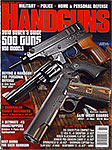
NEW MACHO MINI: KAHR P380
An engineering .380 ACP masterpiece — premium quality pocket-sized defender!
Handguns, 2010 Buyers Guide, p. 4 - 9 By Mike Detty / Photos by Steve Woods
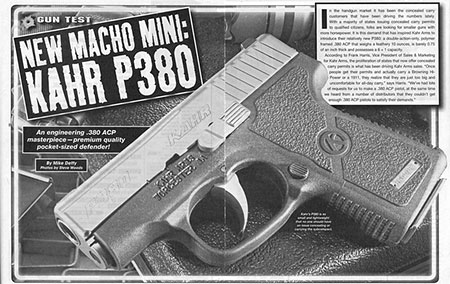 Kahr's P380 is so small and lightweight that no one should have an issue concealing or carrying the subcompact.
Kahr's P380 is so small and lightweight that no one should have an issue concealing or carrying the subcompact.
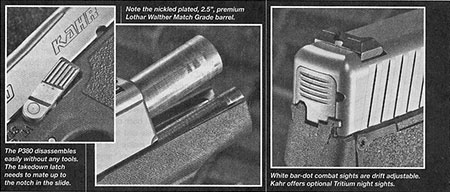 Left: The P380 disassembles easily without any tools. The takedown latch needs to mate up to the notch in the slide.
Center: Note the nickled plated, 2.5”, premium Lothar Walther Match Grade barrel.
Right: White bar-dot combat sights are drift adjustable. Kahr offers optional Tritium night sights.
Left: The P380 disassembles easily without any tools. The takedown latch needs to mate up to the notch in the slide.
Center: Note the nickled plated, 2.5”, premium Lothar Walther Match Grade barrel.
Right: White bar-dot combat sights are drift adjustable. Kahr offers optional Tritium night sights.In the handgun market it has been the concealed carry customers that have been driving the numbers lately. With a majority of states issuing concealed carry permits to qualified citizens, folks are looking for smaller guns with more horsepower. It is this demand that has inspired Kahr Arms to introduce their relatively new P380: a double-action-only, polymer framed .380 ACP that weighs a feathery 10 ounces, is barely 0.75 of an inch thick and possesses a 6 + 1 capacity.
According to Frank Harris, Vice President of Sales & Marketing for Kahr Arms, the proliferation of states that now offer concealed carry permits is what has been driving Kahr Arms sales. “Once people get their permits and actually carry a Browning Hi-Power or a 1911, they realize that they are just too big and uncomfortable for all-day carry,” says Harris. “We’ve had lots of requests for us to make a .380 ACP pistol, at the same time we heard from a number of distributors that they couldn’t get enough .380 ACP pistols to satisfy their demands.”
Harris went on to say that Kahr was positioning the P380 as a premium product. “We know there are plenty of people that are willing to pay more for a quality piece. That’s why we didn’t cut any corners on the P380, we use a match grade Lothar Walther barrel and include two magazines with each gun.”
Gun Details
Indeed, after having a couple months to carry and shoot the tiny gun I can enthusiastically say that the P380 possesses the usual quality that we associate with Kahr pistols. Though each of the gun’s parts was made specifically for the P380, the newest pistol follows the same template as other Kahr polymer pistols. Patents that Kahr owns covering their DAO trigger, internal cocking cam, trigger bar, offset feedramp/barrel lug and one-piece metal insert in the frame are all used on the new P380.
Kahr actually molds a stainless steel insert into its polymer frame. Not only does this make the frame more rigid but the exposed rails also give a metal surface for the slide to ride on, preventing any plastic to metal contact which would accelerate wear. Additionally, the slide’s dust cover has grooves that the exposed steel flanges ride on either side of the frame’s dust cover. While their addition may be superfluous, the slide does track and reciprocate smoothly and I do not see any downside to their inclusion. The polymer frame features grenade-style checkering on the front and back straps and the side grip panels possess texturing all with the purpose of providing the shooter with a secure firing grip.
Many people are turned off by lightweight .380 ACP pistols because they can sometimes be nasty little buggers to shoot. Blowback operated guns with polymer or aluminum frames tend to have sharp recoil, excluding it from use by those who might be recoil sensitive. Happily, the Kahr pistol fires from a locked breech and is very controllable. The difference between a Kahr P380 and a Walther PPK, both chambered for the same .380 ACP round, is very noticeable. This despite the fact that the Walther weighs twice as much but uses blowback operation.
Like Sig Sauers and Glocks, the Kahr uses the square shoulder of the barrel’s breech block to lock into the slide’s ejection port. The slide stop-pin goes through the kidney-shaped barrel lug and cams the rear of the barrel down as the slide reciprocates. This spreads the recoil impulse over a longer time and gives the shooter the perception of reduced recoil. This seemingly small design feature is instrumental in making this lightweight and diminutive pistol controllable.
Another patented Kahr feature that aids in controlling the gun is its offset feedramp/ barrel lug. By relieving half of the barrel lug, Kahr engineers were able to place the trigger bar next to the lug instead of under it. This dramatically reduced the height of the pistol and puts the shooter’s hand closer to the bore’s axis, thus reducing the fulcrum effect and muzzle lift.
The barrel itself starts as a match grade Lothar Walther barrel blank and is contoured and chambered at Kahr’s manufacturing facility. For corrosion resistance, Kahr has the barrel nickel-plated.
There is a very limited amount of space under the barrel for a recoil spring and I doubt seriously if it would be possible to use a single spring that would cycle the slide properly. Kahr engineers solved this dilemma by using two springs, one inside the other, wound in opposite directions and both wrapped around a steel recoil spring guide. This solution provides the proper amount of spring resistance, yet the slide can easily be cycled by hand.
Without a doubt, anytime you design a subcompact size gun there are a number of engineering problems that must be overcome. I asked Kahr’s Frank Harris what the most difficult part of designing the P380 was. His reply was that there were so many different types of ammunition available that it was a challenge to get the gun to run with all of them. In fact, the P380 was in development for over two years and much of this time was spent ensuring that the gun would function with most types of ammo. Says Harris, “The aluminum cased stuff with their hard primers and the +P ammo with extraction all presented problems. It’s tough to get a gun that small to work well with these different types of ammunitions under various conditions.”
It certainly looks like the time Kahr Arms spent on development was worthwhile because my test and evaluation sample was completely reliable. I tested a broad array of ammunition, everything from relatively mild FMJ rounds to really hot +P rounds, and have yet to experience a stoppage.
Defensive Ammo
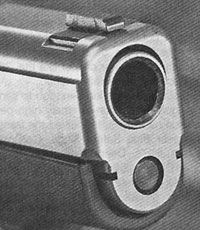 Dust cover has grooves that the frame’s steel insert, which protrudes from both sides of the plastic in the frame’s dust cover, which aids in guiding the slide.
Dust cover has grooves that the frame’s steel insert, which protrudes from both sides of the plastic in the frame’s dust cover, which aids in guiding the slide.
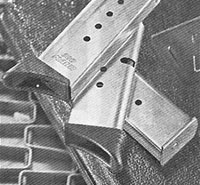 The P380’s capacity is 6 + 1 and the pistol comes with two mags.
The P380’s capacity is 6 + 1 and the pistol comes with two mags.
If you’ve made the decision to carry a subcompact pistol in a minor caliber you have already made the compromise that your comfort and ease of carry are more important to you than your perceived threat. There’s nothing wrong with that. If you live in a decent neighborhood, steer clear of troublemakers and do your best to not be confrontational, chances are good that you’ll never need a gun. But you can’t count on that. For this reason your selection in defense ammunition, especially for a minor caliber like the .380 ACP, becomes especially critical.
Dakota Arms was kind enough to send me a good selection of their high-performance cartridges. I received the frangible Glaser Blue Safety Slugs, CorBon’s 90-grain JHP’s, Deep Penetrating 100% copper DPX hollowpoints and Pow’RBall loads. All of these loads fed and cycled well and produced excellent accuracy. Any number of factors will dictate which load is right for you. My best advice would be to check out their website and see which product best suits your needs.
I also got a small sampling of Enhanced Penetration Rounds (EPR) from Extreme Shock Ammunition. Quoting their catalog, “EPR was engineered for applications where greater penetration is a must. The EPR has greater terminal success through glass and wood. This round has the ability to penetrate dense bone and then fragment once inside the softer tissue of the target.” Like the other high performance ammos I tried, the P380 worked flawlessly with these rounds. Recoil was noticeably sharper but the upside of this equation is that it produced 22% more energy than the next closest ammunition, the Glaser Safety slugs.
Shooting Impressions
I thought the ideal range to test this gun for accuracy is 15-yards. Realistically, this gun will be used at arm’s length distances but I was curious about its mechanical accuracy. Shooting from a bench and utilizing a Millett Benchmaster for support, I managed to fire 5-shot groups under 1.5 inches with over half of the ammunitions tried. Even my worst group was less than 2.5 inches. Again, for its intended purpose, I think the P380 possesses far more mechanical accuracy than users will ever need or want.
I am always impressed with Kahr’s DAO triggers. They are smooth and consistent and have absolutely no stacking while it is pulled through its arc. My test sample’s trigger broke at about 7 pounds though it is so smooth it feels lighter. Each trigger pull is exactly the same from the first to the last shot. Pulling the trigger releases the striker so there is no second strike capability.
My one minor criticism of the P380 is that its front sight is just too short to pick up quickly. I noticed while I shot the gun from the bench that it took an extra degree of attention on my part to find the front sight and center it in the rear sight. As it was, my test gun already shot about 2.5 inches low at 15-yards, and making the front sight taller would have it shooting even lower. In order to make the front sight taller it would require making the rear sight taller as well, which would be counterproductive for a pocket size subcompact pistol.
I also took the gun out into the desert with some steel targets to see how well it could shoot rapidly. I was curious to see how it handles and was concerned that it may be so small that its size would cause me to compromise my grip and thus my ability to fire it effectively. Due to its lack of muzzle flip, I found that I could empty a magazine of bullets onto the target without missing a beat. The gun was controllable and allowed me to fire accurately. In fact, I didn’t feel as though I needed to adjust anything to compensate for the gun’s small size, and that is a good thing.
| PERFORMANCE: KAHR P380 .380 ACP | |||
|---|---|---|---|
| Load | Velocity | Accuracy | |
| CorBon 90 JHP | 921 | 1.19 | |
| CorBon 80 DPX Hollow Point | 961 | 1.26 | |
| CorBon Pow’RBall 70 | 1038 | 1.23 | |
| Extreme Shock 90 | 1051 | 2.19 | |
| Glaser Blue Safety Slug 70 | 1056 | 2.46 | |
| Winchester 95 FMJ | 767 | 1.36 | |
| Winchester 95 SXT Hollow Point | 874 | 1.79 | |
| Bullet weight measured in grains, velocity in feet per second (fps) by a PACT Chronograph, and accuracy in inches for 5-shot groups from a seated rest using a Millett Benchmasler from 15 yards. | |||
Final Notes
Those looking for an unobtrusive concealed carry gun or back-up would do well to examine the new P380 from Kahr Arms. Its lightweight and extreme thinness make it easily concealable regardless of your size or wardrobe. Not only is it reliable and accurate, it is also very controllable. It is one of the most size-efficient firearms that I am aware of and has become my most carried pistol. If your needs don’t demand a full-size gun like the 1911 yet you still feel uncomfortable going about your business unarmed, the P380 may be the right gun for you.
<< Go back to Previous Page